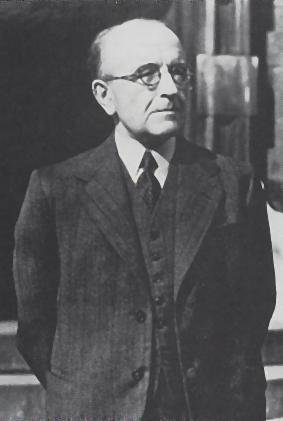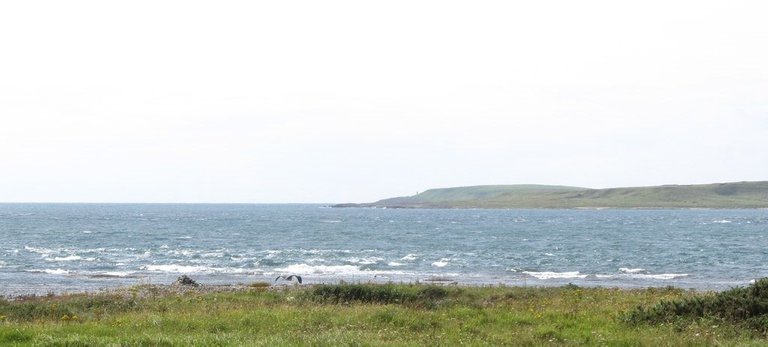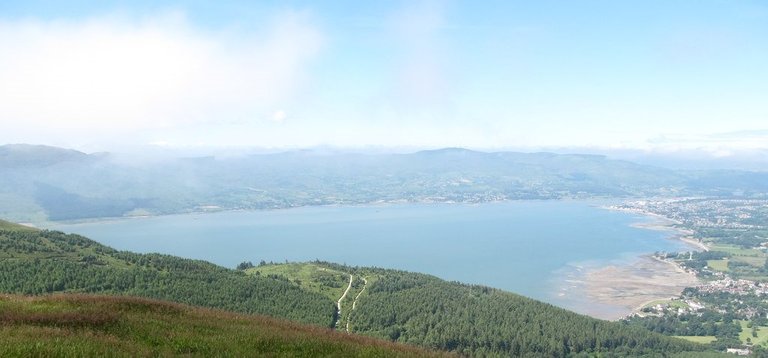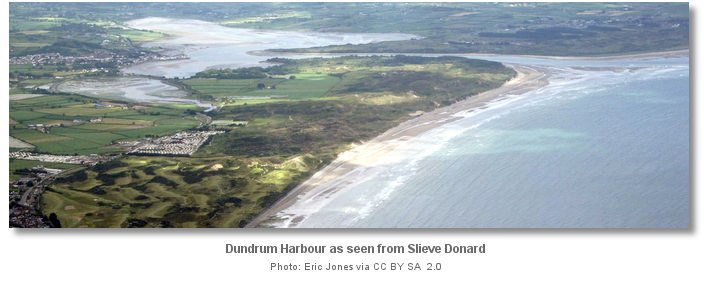
After Bouvinda and Isamnion, the next coastal feature on Claudius Ptolemy’s map of Ireland is Οὐινδεριος Ποταμου Εκβολαι, or Mouth of the River Vinderis. Here Ptolemy’s Οὐινδεριος [Vinderios] is the genitive singular of Οὐινδερις [Vinderis], governed by εκβολαι, mouth [of a river]. In Ptolemy’s day, Greek nouns with i stems, such as πολις, formed their genitives in -εως: πολεως. But in older dialects of Greek, such as that found in the Homeric poems, the genitive of πολις was πολιος. This is exactly what we find in Proto Celtic, as Thurneysen notes in A Grammar of Old Irish:
Case-Forms of i-Stems: 303. Singular Nom[inative] masc[uline and] fem[inine]. The palatal final points to earlier -is ... Gen[itive] ... In [Indo-European] there were certain i-stems with genitive in (i)ios, cp. ... Gk. πόλις, gen. (Homer) πόλιος; (Thurneysen 192-193)
| Nominative | Genitive |
|---|---|
| πολις | πολιος |
| Οὐινδερις | Οὐινδεριος |
Liddell & Scott (1240) refer to this as the Doric genitive. It occurs in the Iliad (2:811), where πόλις is governed by the preposition προπάροιθε, before, in front of. Wilhelm Dittenberger also includes an example in Volume 2 of his Sylloge Inscriptionum Graecarum (Dittenberger 615.3).
Thurneysen’s point has been reiterated more recently by Patrizia de Bernardo Stempel of the University of the Basque Country:
In the case of the short i-stems, it is simply the archaic singular genitive/ablative case in *-yos, which ... is continued by three different, phonetically produced allomorphs ... In the “normal” subtype, the original ending *-yos is left unchanged, as in the genitive Οὐινδέριος—attested by Ptolemy—of the Irish river name Vinderis “The whitest [river]. (Stempel 2013:66)
If you have been following this series, you will not have to be told why Ptolemy uses the Greek digraph ου to represent the Celtic letter v (which was probably pronounced as the semi-vowel [w]), but for those who have not read the previous installments, here’s why:

The name ’Ιέρνη, “Ireland”, had probably been picked up by the Massaliot Greeks, from merchants and from their Celtic neighbours, as early as the fifth century B.C. ... The digamma had disappeared from Ionic as early as the seventh century B.C.; and when Massaliot Greeks first heard the name Īvernā [Ireland], they presumably had no means of indicating the -v- and simply dropped it. Later the Greeks adopted the expedient of representing v in foreign names by ου ... We may take it that Pytheas retained the traditional name ’Ιέρνη ... whereas in dealing with other names previously unrecorded, we find him representing Celtic v by Greek ου, as for instance in ... Bouvinda [Βουουινδα] ... Ptolemy, or some near predecessor of his, modernized ’Ιέρνη into ’Ιουερνία [Ivernia] ... (O’Rahilly 41-42)
Ptolemy's Coordinates

The three modern editions that I have been following—Müller, Wilberg and Nobbe—agree on the latitude and longitude of the Vinderis, as do the earliest and most reliable sources. A few of the later, less reputable sources place the Vinderis in latitude 61° 15' instead of 60° 15', or in longitude 16° instead of 15°.
| Edition or Source | Longitude | Latitude |
|---|---|---|
| Müller | 15° 00' | 60° 15' |
| Wilberg | 15° 00' | 60° 15' |
| Nobbe | 15° 00' | 60° 15' |
| Vaticanus Graecus 191 | 15° 00' | 60° 15' |
| 4805 | 16° 00' | 60° 15' |
| A | 15° 00' | 61° 15' |
Sources: Müller (1883), Wilberg (1838)
Variant Readings
A number of variant readings may also be noted, although there is a scholarly consensus that Vinderis (or Winderis) is the correct and original form. None of these variants occurs in any of the earliest sources:
| Greek Genitive | Greek Nominative | Roman Nominative |
|---|---|---|
| ’Ιουνδέριος | ’Ιουνδέρις | Iunderis |
| ’Ιουνδέριου | ’Ιουνδέριος | Iunderios |
Identity of the River Vinderis
The River Vinderis is another of those Ptolemaic features whose identities are still matters of scholarly debate, with no consensus having been reached on the subject. If this feature has not been misplaced, then the best we can say is that it is a river which discharges into the Irish Sea somewhere between the mouths of the Boyne and the Lagan—as these two rivers have been firmly identified with Ptolemy’s Bouvinda and Logia. Ptolemy also places the Vinderis north of Isamnion, but the identity of Isamnion is still disputed.

There are several rivers along this stretch of coast that must be considered, but none of them is as well known as the other rivers in this part of Ptolemy’s map (the Slaney, the Liffey, the Boyne and the Lagan). There are also a number of inlets—such as Carlingford Lough and Strangford Lough—which have come under consideration.
One of the earliest attempts to provide an etymology for Ptolemy’s term was given by Walter Harris, in his edition of The Whole Works of Sir James Ware. Ware had identified the Vinderius, as he called it, with the Bay of Carrickfergus [ie Belfast Lough] or the Mouth of the River Lagan, to which Harris added the following comment:
The British again in some of their Dialects deduce Vinderius from Vind-e-riu, or the Head of the River or Æstuary, and they say that in the antient Dialects of the Welsh Vand, Vend, Vind, and Vond, are the same as Cand, Kend, Kind, and Cond, all which signifie the head, as the other part of the Compound does a River. (Harris 44)
This etymology is no longer taken seriously. In the 19th century, Karl Müller suggested that the Vinderis was the small river that entered the sea at Dundrum—ie the Castletown River—but he offered no etymology (Müller 79). Goddard Orpen also hesitated to offer any etymology:
We next come to a river mouth called Οὐινδεριος (v.l. ’Ιουνδέριος), which from its position ought to be near Dundrum Bay, or perhaps Carlingford Lough, (Orpen 127)

In the early 20th century Charles Trice Martin suggested Belfast Lough or Strangford Lough. More recently, Alan Mac an Bhaird has suggested the River Quoile, which discharges into Strangford Lough. I must confess, until I began to research this subject I had never even heard of the River Quoile.
Among modern linguists, the main bone of contention is whether the initial element in Vinderis signifies white or pleasant. I have already quoted Patrizia de Bernardo Stempel, who interprets Vinderis as signifying whitest. This etymology is disputed by the contributors to the Roman Era Names website:
Ουινδεριος (or Ιουινδεριος) river mouth (Winderios 2,2,8) probably meant something like ‘pleasant river’, which does not much help in deciding between possible candidates that would fit Ptolemy’s coordinates: Strangford Lough, suggested by Warner (2013); or the small river Fane well to the south, suggested by Gusev et al; or Dundalk Harbour, which is fed by at least four rivers. This name starts like Vindo-, seen in place names in Britain and elsewhere, which is commonly claimed to be Celtic for ‘white’ but is much more likely to mean ‘pleasant, happy’, from the PIE root *wen-, whose descendants include OI fine ‘clan, family’, English winsome, Latin Venus, etc. The -rios part probably came from PIE *reiə- (or *er-) ‘to flow (fast)’, as in the river Rhine or OE ryne ‘water channel’. (Roman Era Names. Note that the variant reading given by Roman Era Names—Ιουινδεριος—has been misspelt.)
There is, in fact, a river called White River which flows through County Louth north of the Boyne. It is, however, only a tributary of the River Dee, so its name is unlikely to be connected with Ptolemy’s Vinderis, even if the latter does mean something like white flow or whitest.

It is curious that no one seems to have considered the River Newry. Before I began to research this subject, if someone had asked me to name a river between the Boyne and the Lagan, the Newry is probably the only one I could have named. The Newry discharges into Carlingford Lough, so perhaps it is covered by the latter, which Orpen and Stempel mentioned in their analyses. The Newry also lies north of Dún Dealgan and the Cooley Peninsula, places that have been linked in the past with Ptolemy’s Isamnion.
Louis Francis’s Larne Lough is surely too far north to be the Vinderis.
Dundrum Bay
Richard B Warner, the former Keeper of Archaeology and Head of History in the Ulster Museum, has recently identified the Vinderis with with the inlet between the inner and outer bays at Dundrum, County Down:
The highly dangerous sand-bars and white-water waves at the mouth of the inlet are explanation enough for the name, which appears to mean ‘the whitest (river)’. The dangerous nature of the inlet might also explain why, despite its being a fairly minor feature, it was included on Ptolemy’s map. (Warner 63)

| Castletown River | Dundrum Bay | Strangford Lough | Quoile | Belfast Lough (Lagan) | Carlingford Lough | Larne Lough | |
|---|---|---|---|---|---|---|---|
| - | - | - | - | Camden (1607) | - | - | |
| - | - | - | - | Ware (1654) | - | - | |
| Müller (1883) | - | - | - | - | - | - | |
| - | Orpen (1894) | - | - | - | Orpen | - | |
| - | - | Martin (1910) | - | Martin | - | - | |
| - | - | - | Mac an Bhaird (1991-93) | - | - | - | |
| - | - | - | - | - | - | Francis (1994) | |
| - | - | - | - | - | Stempel (2000) | - | |
| - | - | Darcy & Flynn (2008) | - | - | - | - | |
| - | Warner (2018) | - | - | - | - | - |
Source: Darcy & Flynn 57
If I had to choose, I would opt for the Newry River or Carlingford Lough, though I find Warner's theory intriguing. The Vinderis is probably one of those toponyms in Ptolemy’s Geography that will never be definitively identified.
References
- Robert Darcy & William Flynn, Ptolemy’s Map of Ireland: A Modern Decoding, Irish Geography, Volume 41, Number 1, pp 49-69, Geographical Society of Ireland, Taylor and Francis, Routledge, Abingdon (2008)
- Wilhelm Dittenberger (editor), Sylloge Inscriptionum Graecarum, Volume 2, S Hirzel Verlag, Leipzig (1917)
- Henry George Liddell, Robert Scott, A Greek-English Lexicon, Eighth Edition, American Book Company, New York (1901)
- Charles Trice Martin, The Record Interpreter: A Collection of Abbreviations, Latin Words and Names Used in English Historical Manuscripts and Records, Reeves and Turner, London (1892)
- Karl Wilhelm Ludwig Müller (editor & translator), Klaudiou Ptolemaiou Geographike Hyphegesis (Claudii Ptolemæi Geographia), Volume 1, Alfredo Firmin Didot, Paris (1883)
- Karl Friedrich August Nobbe, Claudii Ptolemaei Geographia, Volume 2, Karl Tauchnitz, Leipzig (1845)
- Thomas F O’Rahilly, Early Irish History and Mythology, Dublin Institute for Advanced Studies, Dublin (1946, 1984)
- Goddard H Orpen, Ptolemy’s Map of Ireland, The Journal of the Royal Society of Antiquaries of Ireland, Volume 4 (Fifth Series), Volume 24 (Consecutive Series), pp 115-128, Dublin (1894)
- Claudius Ptolemaeus, Geography, Biblioteca Apostolica Vaticana, Vat Gr 191, fol 127-172 (Ireland: 138v–139r)
- Patrizia de Bernardo Stempel, Ptolemy’s Celtic Italy and Ireland: A Linguistic Analysis, in David N Parsons & Patrick P Sims-Williams (editors) Ptolemy: Towards a Linguistic Atlas of the Earliest Celtic Placenames of Europe, University of Wales, CMCS Publications, Aberystwyth (2000)
- Patrizia de Bernardo Stempel, The Phonetic Interface of Word Formation in Continental Celtic, in Juan Luis García Alonzo (editor), Continental Celtic Word Formation. The Onomastic Data, Ediciones Universidad de Salamanca, Salamanca (2013)
- Rudolf Thurneysen, Osborn Bergin (translator), D A Binchy (translator), A Grammar of Old Irish, Translated from Handbuch des Altirischen (1909), Dublin Institute for Advanced Studies, Dublin (1946, 1998)
- James Ware, Walter Harris (editor), The Whole Works of Sir James Ware, Volume 2, Walter Harris, Dublin (1745)
- Richard B warner, Ptolemy's River Winderis: A Corrected Identification, a Sea-Monster and Roman Material from the Adjacent Sandhills, Emania, Number 24, pp 63-67 Navan Research Group, Belfast (2018)
- Friedrich Wilhelm Wilberg, Claudii Ptolemaei Geographiae, Libri Octo: Graece et Latine ad Codicum Manu Scriptorum Fidem Edidit Frid. Guil. Wilberg, Essendiae Sumptibus et Typis G.D. Baedeker, Essen (1838)
Image Credits
- Ptolemy’s Map of Ireland: Wikimedia Commons, Nicholaus Germanus (cartographer), Public Domain
- Greek Letters: Wikimedia Commons, Future Perfect at Sunrise (artist), Public Domain
- T F O’Rahilly: Copyright Unknown, Fair Use
- Strangford Lough: Geograph Ireland, © Eric Jones, Creative Commons License
- Carlingford Lough: Geograph Ireland, © Eric Jones, Creative Commons License

Your every post is really great and interesting. I like it. ❤️ U
Great history about ireland.. bro @harlotscurse...
Wonderful and awesome blog .. I am your new follower.. I am glad to read your blog post..and #resteem done..
Hey, @harlotscurse your writing is amazing. wonderful history about ireland.post resteemed.i like your post.
@alizafatima99 - You may not realize that "like your post" is considered to be spam, you used 51 similar phrases in your last 100 comments, I've replied to you 13 times before, you've received 13 flags, and the Steem Sincerity API shows a 52.50% spam score. Learn why this is spam and a few better ways to earn the support of the community when commenting.
@harlotscurse - You can remove this comment and everyone can whitelist me from appearing in future posts.
you give brief descriptions about it .. thats why its become easy for us to understand,, great writting here ... lot more information is obtained in this post..great history of ireland..very welldone..my dear friend.. @harlotscurse
Excellent research and very deep that leads us to know the origin of many names and geographical discoveries
Excellent article and photography dear @harlotscurse
there has many things to learn from you dear..
I appreciate your post..
thanks a lot dear @harlotscurse for sharing about the history of @ireland
that's a great history & nice post about ireland dear @harlotscurse
thanks for sharing such a learning post..
@ayeshasiddika - You may not realize that "nice post","thanks for sharing" is considered to be spam, you used 43 similar phrases in your last 100 comments, I've replied to you 3 times before, and the Steem Sincerity API shows a 52.90% spam score. Learn why this is spam and a few better ways to earn the support of the community when commenting.
@harlotscurse - You can remove this comment and everyone can whitelist me from appearing in future posts.
excellent post,my dear friend @harlotscurse,very good history,i really love this post all time,thanks for share,
this post has been #upvote and #comment,
Great story, really very best history of ireland.... I thought it was interesting how you tell and develop the story about it! great job...thanks to sharing for your good thought post.. dear....... .... friend @harlotscurse
The story is quite complete, I learned a lot about this topic, you really take the time to make a good informative article that provides knowledge to other people. You are a great contribution to the steemit community.
I really like your blog, it's full of important information and you see that you love what you do.
Great story, I really liked reading it!
Excellent written friend very good post you do a great job in every post you post thanks for sharing with us
I heard so much thing about white river. My cousin stay in Ireland
Very interesting story friend xcelent post is a great contribution that you make good post success and blessings
@andreina89 - You may not realize that "good post" is considered to be spam, you used 45 similar phrases in your last 100 comments, I've replied to you 46 times before, you've received 1 flag, and the Steem Sincerity API shows a 77.90% spam score. Learn why this is spam and a few better ways to earn the support of the community when commenting.
@harlotscurse - You can remove this comment and everyone can whitelist me from appearing in future posts.
nice history
Excellent post dear. Love you.. i follow u always